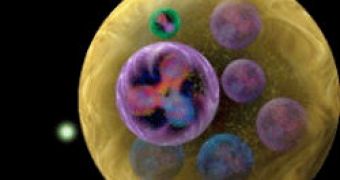Usually, two-quark particles such as pions are absorbed into the atomic nucleus right after they are produced, but in some cases they can escape, and are ejected out of the system. Their low energy makes the detection close to impossible, thus they are called color transparent particles. A new study believes otherwise and claims that it was able to detect such low energy particles, which is kind of controversial considering that most experiments in nuclear physics are carried out at rather high energies, in order to remove the uncertainty.
Quarks are elementary particles that compose neutrons, protons and a series of other particles, and exert forces of attractions between each other, in a similar way to the electric charge. They do not exist freely in the universe, as they decay rapidly through quark annihilation processes or by recombination in order to form a new particle. The force of attraction between them will occasionally bundle quarks together into groups of two or three, to create particles such as protons or mesons.
Elementary particles created out of quarks may range in different sizes, thus the size of a particle would be the average size of all the possible quark combinations that exist simultaneously, rendering the particle temporarily invisible in relation to the other interactions within the nucleus that enables it to escape.
Such processes have been only observed in particle accelerators at energies higher than 50 Giga-electron-Volt, but the theory predicts that the color transparency should also exist at lower energies, regardless the fact that they cannot be observed.
Gerard Miller from the University of Washington claims that they have evidence of observing color transparency of pion particles at medium energies. The experiment, conducted at the Jefferson Lab, involved using an electron beam to study collisions at energies of about 5 GeV. Electrons striking protons inside the atomic nucleus would determine the emission of a pion particle, which would convert the proton into a neutron particle. Miller argues that in his experiment more than 60 percent of the pion particles with energies about 2.5 GeV succeeded in escaping the nucleus, respectively 75 percent of the particles with energies of 5 GeV.
However, some nuclear physicists aren't completely convinced, especially in the matter of sorting the color transparent pions out of the huge number of normal pion particles. Rho meson experiments have shown previously that color transparency processes aren't energy dependent, thus Miller's experiment is looking a little shaky. A separate group of nuclear physicists claim that color transparency is also dependent on atomic nuclei size, and consider their finding to be a further proof that the results obtained through the experiments at the University of Washington are correct.

 14 DAY TRIAL //
14 DAY TRIAL //